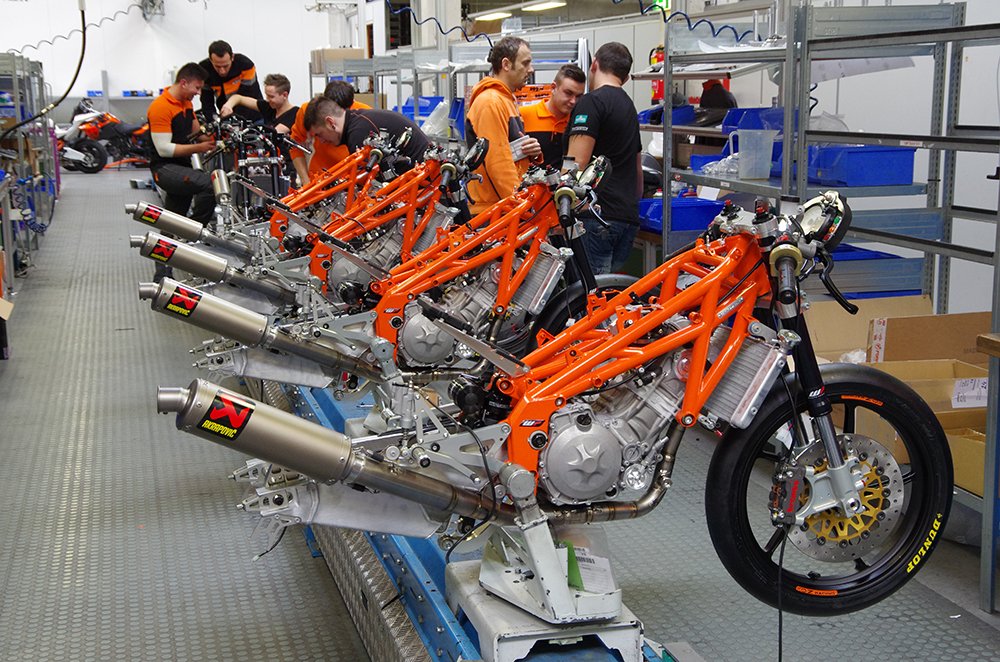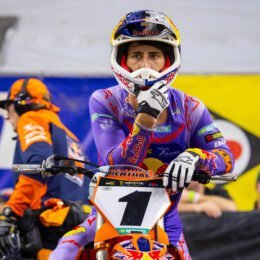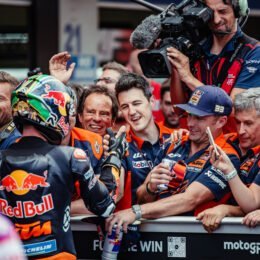Building a Moto3 bike…
You’ll be hard pushed to find a manufacturer more involved in sport than the Orange camp. The next step in the immensely successful Moto3 programme is a small production run of pure race bikes for customer teams and upcoming riders. To fulfil this and meet demand a run of 40 Moto3 machines have been assembled in Mattighofen. Aside from some small details the new RC250R is a replica of the world championship winning motorcycle with which Sandro Cortese clinched the title in 2012.
A quantity of 40 bikes is too big to be built by a couple of specialists in the race department. At the same time it is not enough to be handled through one of the main four production lines in KTM´s factory. So the assembly of the race replicas came down to production line No. 5, which is otherwise used for training on standard motorcycle models. This line is shorter and more flexible, so it´s the perfect fit for reduced numbers of special or limited editions.
As can be expected for this type of bike the industrial production level of the RC250R is extremely high. Concept and development was handled directly by KTM’s factory race department, which for specific tasks can rely on capable manpower and knowledge and then also be able to seek assistance from the mighty R&D division. After a winter of labour all parts needed for the production process had been engineered, manufactured or produced in-house or by proven manufacturers and suppliers.
The final meticulous process of construction happened in three phases (because production line no. 5 is pretty short). About 10 employees smoothly worked away for two weeks to finish the build. A couple of young mechanics in the final advanced stages of their apprenticeship were also involved and – as you might imagine – the RC assembly was a hugely enticing project. Fabrication and delivery of the Moto3 single cylinder engines came down to KTM´s ‘Motorenwerk’ (engine factory) in the nearby village of Munderfing. The beautiful frames also came from the same location as these are fabricated at KTM’s sister company WP Performance Systems, who also create and weld the frames for all orange street bikes. KTM’s chassis-fabrication process changed this winter from a former production facility inside Mattighofen to a newly built und very impressive WP factory complex, where suspension parts as well as frames are now produced.
The new KTM RC250R presents itself as a no compromise race-tool. Super compact and forged with incredible dedication to detail, everything is perfect and a shining example of purpose-built-engineering with quality components. Upside-down forks and the rear shock are supplied by WP and braking equipment is from Brembo. Dunlop slicks are mounted on forged aluminium wheels from OZ-Racing. Italian firm GET by Athena supplied the electronics, Koso the race Dash. Some parts are fabricated from billet aluminium (triple clamps, handlebar clamps). All carbon-parts (fairing, sub frame/seat, fenders) are supplied by Wethje. German fabricator specialist MAFO Systemtechnik welded the eye-catching aluminium swing arms. Pistons and conrods are made by renowned racing company Pankl Racing Systems. Akrapovic performed their magic on the titanium exhaust system.
The 250cc four-stroke missiles will be raced in national Moto3 championships series. For example in the German IDM, the Italian CIV, Spain’s CEV and Britain’s BSB. It is interesting to note that most customers prefer to pick up their pre-ordered bikes directly from the factory in Austria (instead of choosing some kind of courier system). Maybe because the trip presents a good opportunity to grab and pack in what is otherwise part of the RC250R package: race-stand, selection of sprockets, special tools, service-handbook, spare parts catalogue, download-cable, decoration sticker sets and more.
Road racing in the past with two-strokes had its complications; also the ‘simple’ technology actually needed quite some attention from a mechanical point of view (frequent head checks and cylinders maintenance). KTM’s new Moto3 racer with modern four-stroke-technology impresses with pretty long engine hour revisions: with revs up to 13.500rpm, the service intervals are 4000km. If you want to rev 14.000/min for some extra power, go for it, no problem. In this case KTM recommends only 2000km intervals.
So, what is the difference between the production racer and the Moto3 bike used in Grand Prix? Senior Engineer Wolfgang Felber, head of KTM customer racing, explains: “The differences come through some little details. The GP bike for example runs with the regulation enforced Dell’Orto electronics unit, has a different Akrapovic exhaust system, magnesium wheels, and modified brakes as well as WP factory suspension parts, which help to save some more weight.”
KTM has supplied machinery for the Red Bull Rookie series for a couple years now and this feeder class will switch to four-stroke and Moto3 technology. So alongside the 40 units on the production line KTM also had to fabricate all necessary parts for another 27 RC250R race-bikes (24 plus 3 reserves). Packed as ready-to-assemble-kits they are sent to Spain to be assembled in the HQ of the Rookies Cup at Manresa near Barcelona. The Rookies machinery is handled this way in order to allow cup technicians and mechanics to be fully familiar with the new four-stroke racers right from the beginning.
TECHNICAL DATA FOR THE KTM RC 250 R, Production Racer 2013
DRIVE
Engine: Single cylinder, 4-stroke, DOHC
Displacement: 249.5 ccm
Bore/Stroke: 81/48.5 mm
Power: min. 37 kW (50 PS) at 13.000 rpm
Max. torque: 28 Nm at 11.000 rpm
Compression ratio: 14,5
Battery: 12 V / 0.8 Ah
Gear box: 6 speed cassette gear box, 2 optional ratio versions
Intake system: dual injector throttle body, oval, Ø 50 mm equivalent
Cooling system: WP water radiator + WP oil-water heat exchanger
Generator: 12 V / 70 W
Lubrication: semi dry sump, 1 pressure pump, 2 suction pumps
Primary drive: straight teeth gear drive
Valvetrain system: chain drive, intermediate gear, radial valves, DLC-coated finger followers
Clutch system: multi disc wet clutch
Motor management/ignition: GET by Athena ECU, GET by Athena Software MAYA EVO. Adjustable motor brake, traction control, launch control, fuel mapping, ignition mapping, pit speed limiter and quickshifter. Interface for data recording.
CHASSIS
Frame: tubular steel trellis frame with adjustable headstock and swingarm pivot
Subframe: Wethje carbonfibre composite, monoblock
Swingarm: Upside down shaped, welded aluminium
Handlebars: clamps milled from billet aluminium, changeable handlebar tubes
Front suspension: WP USD fork RCMA 3548 / Ø 35 mm, adjustable spring preload, adjustable compression and rebound damping, 20 clicks
Rear suspension: WP rear shock BAVP 4618, adjustable shock length, hydraulic preload adjuster, adjustable High-/Low-Speed- compression damping and rebound damping, 20 clicks
Triple clamps: milled from billet aluminium, adjustable, 28/30 mm offset
Front brake: Brembo single disk, 290 mm Ø, Brembo radial caliper and radial master cylinder
Rear brakes: Braking, disk 190 mm Ø, Formula radial caliper and Formula master cylinder
Front/rear wheel: OZ forged aluminum 2.5 x 17’’
/ 3.5 x 17’’
Front/rear tire: Dunlop 95/75-R17 / 115/75-R17 / Moto3 M Slick
Secondary drive: 415 chain, sprocket options 16 – 18T, rear sprocket options 34 – 42T
Exhaust: Akrapovic full titanium system single silencer, 107 dB, additional 100/103 dB killer
Steering head angle: ± 1° adjustable with optional headshock inserts
Swingarm pivot: ± 4 mm adjustable with optional swingarm pivot inserts
Wheel base: 1210 mm ± 35 mm
Ride height: adjustable ± 6 mm
Seat height: 760 mm
Tank capacity: approx. 10.5 litres
Dry weight: approx. 82 kg (without fuel)
ORIGINS
GP125: geometry, ergonomic, aerodynamic components
MOTOGP engine: layout cylinder head and throttle body
RC8 R SBK: electronic, frame knowhow, materials processing
MX: lubrication system, transmission, clutch, kinematic valve gear
























